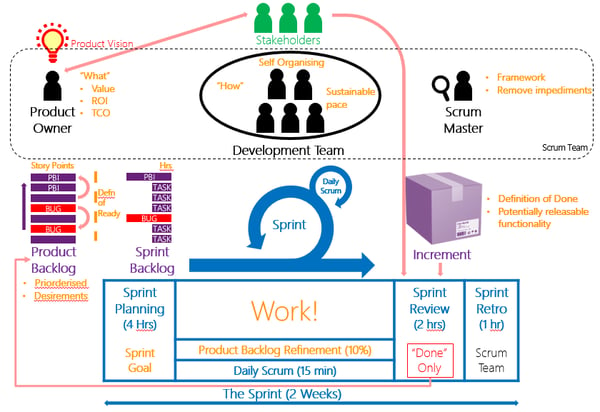Intro
During the last couple of months the nFocus team have enjoyed meeting hundreds of IT professionals at a series of events that include the IP Expo, Test Expo and many more. Whilst manning a stand for several days is exhausting on the legs, it is made worthwhile by the interesting (and sometimes bizarre) questions we’re asked. As you would imagine, the common themes included how testing fits into DevOps and interestingly Agile vs Scrum. This article is going to focus on the latter.
Agile vs Scrum
Scrum is part of the Agile movement and is an Agile framework for completing complex projects. For that reason the phrase Agile vs Scrum makes no sense. If you're doing Scrum, you are Agile.
A definition of Scrum from the Scrum Guide by Schwaber & Sutherland (2013) - Scrum (n): A framework within which people can address complex adaptive problems, while productively and creatively delivering products of the highest possible value.
Scrum is founded on empirical process control theory. The three pillars that uphold every implementation of empirical process control are:
- transparency
- inspection
- adaptation
I've included the common 'Scrum in three minutes graphic' below for your reference.

The development team perform sprint planning which breaks the PBI down into tasks that need to be executed to meet the Definition of Done (DoD) and it’s acceptance criteria, the DoD and Acceptance criteria will require testing tasks to be performed.
The Scrum Master is the custodian of the framework and a leader (not a manager), they are there to coach and mentor the team and remove any impediments.
I've only described a small portion of the picture, and you can already see that it starts to get complicated and one thing that does start to emerge is that the soft skills become important. The term soft skills is somewhat misleading because mastering them is hard. nFocus have deep expertise in helping organisations adopt Agile and Scrum. For more information visit our website.
Why adopt an Agile framework?
The benefits of moving to an Agile framework can benefit organisations immensely. The benefits include:
- increased productivity
- higher quality
- ability to respond more rapidly to market demands
- increased revenue and reduced costs
- increased market share
- and most importantly, higher customer/stakeholder satisfaction!
If you're considering adopting Agile, or putting together a business case to support any element of Agile delivery, we'd recommend the following White Paper:









.png)
